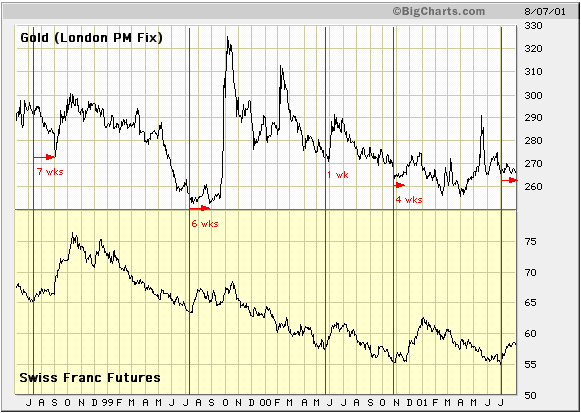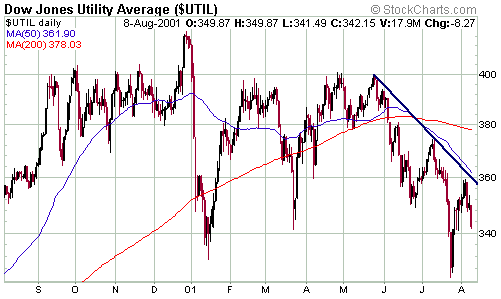|
- 08 August 2001
The US
Stock Market
In the short-term, money trumps
value
Our reading of stock market history
and our own experience tells us that, over a 12-month period, monetary
conditions trump valuations. This is evidenced by the fact that four of
the best years for the stock market during the 1980s and 1990s (1985, 1986,
1991 and 1998) were years during which company earnings fell dramatically
below expectations (the average expectation going into each year was that
earnings would grow by 16%, but the average actual result was a decline
of 6%). The average performance of the S&P500 during these years was
a gain of 24%, thanks primarily to a very supportive monetary environment.
This doesn't mean we should ignore
valuation levels. For example, when valuations are extremely high but the
market is being elevated by a friendly monetary environment, then the stock
indices will tank as soon as the monetary conditions become less supportive.
Similarly, if valuations are low but the market is being held down by an
unfriendly monetary environment, then stock prices are likely to surge
as soon as the monetary conditions begin to improve. What it does mean
is that it makes no sense, over a 12-month period, to lean against the
monetary extremes that occur from time to time regardless of the average
P/E ratios of the major stock indices.
This year is perhaps the biggest test
ever of the power of monetary conditions over valuations, since valuations
are an extreme negative (for many of the large-cap stocks) and the monetary
environment is an extreme positive. The battle is on-going, with the positive
monetary conditions perhaps having a slight edge. In particular, it is
notable that the early-April lows have not been seriously tested despite
a veritable flood of terrible corporate financial results and guidance
since that time.
In our opinion, the reason that money
trumps valuation over the medium-term is that the market is more of a voting
machine than a weighing machine. In other words, over a 12-month period
stock prices are based less on objective valuation criteria than on what
people think they can justify based on some nebulous view of the future.
Over the longer-term, of course, valuations revert to a level determined
by the worth of the underlying businesses.
Valuation Risk
A lot of tech stocks are now priced
at attractive levels. For example, Global Crossing (GX) is now selling
at less than 1-times current year revenue, Motorola (MOT) is selling at
less than 1.5-times current year revenue and Corning (GLW) is selling at
around 2-times revenue. There are, however, many tech stocks that are still
priced at ridiculously-high levels, particularly amongst the semiconductor
stocks. For example, Micron Technology (MU) is selling at 8-times current
year revenue, but that is downright cheap compared to the 24-times revenue
that PMC Sierra (PMCS) is trading at and the incredible 35-times revenue
that today's buyers of Applied Micro Circuits (AMCC) are paying for a slice
of that company. Tech bellwethers Intel (INTC) and Cisco (CSCO), despite
the sharp declines in their stock prices over the past 12 months, are also
priced at nose-bleed levels - Cisco at 7-times revenue and Intel at 8-times
revenue. Compare this to Harmony Gold Mining (HGMCY), a company that is
growing faster than Intel and Cisco but is, of course, part of a sector
of the market that is very much out of favour. With the gold price crawling
along near 20-year lows HGMCY still managed to grow its revenue by 25%
in the latest year and is likely to do the same this year assuming a stable
gold price. And what do investors need to pay to get a slice of Harmony?
A little more than 1-times last year's revenue.
As noted earlier in today's commentary,
when valuations are extremely high but the market is being elevated by
a friendly monetary environment, prices will tank when the monetary conditions
become less supportive. We are bullish taking a 3-month view, but the valuations
make us wary and we will be quick to reverse our position as soon as we
see signs that the monetary tide is beginning to go out.
Current Market Situation
The sharp drop in the major stock indices
on Wednesday makes the technical position of the market more precarious,
but if this ultra-frustrating market stays true to its recent form then
we should soon see another rebound.
Any rebound in the immediate-term is,
however, likely to be short-lived. Put/call ratios have been high over
the past 2 days, but not high enough to make a compelling case that a major
upside reversal is about to occur. Also, daily momentum indicators are
nowhere near oversold. Therefore, lower levels will probably be seen over
the next week.
We think that the major stock indices
will be much higher in 3 months time, but won't initiate a market-general
trading position (eg, QQQ shares or call options) until we see some technical
evidence of a turn or until sentiment indicators return to bell-ringing
levels. In the mean time we'll just stay out of the way.
Gold and
the Dollar
Gold and the Swiss Franc
The following chart compares the gold
price with the Swiss Franc since mid-1998. The vertical red lines indicate
the points at which the SF made a medium-term low. On the gold chart we've
noted the number of weeks that elapsed from the time the SF bottomed and
turned higher to the time the gold price turned higher.

The chart shows that significant upward
reversals in the SF have led upward reversals in the gold price by as few
as one and as many as seven weeks. The gold price also bounced a couple
of times (Feb 2000 and Apr-May 2001) without any assistance from the currency
market.
The upturn in the SF that occurred
in early-July looks real (it looks like the start of a major rally). If
this is the case and history is any guide (the positive correlation between
the gold price and the SF goes back much further than the 3 years depicted
on this chart), then we should expect an upward reversal in the gold price
by August-24 at the latest (August-24 is seven weeks from the July-06 upturn
in the SF). Most likely gold will start to rally as soon as the Dollar
completes its current counter-trend bounce.
Confirmation from the Utilities
The Dow Jones Utilities Index (DJUI)
tends to lead the bond and currency markets. The weakness in the DJUI over
the past 3 months is telling us to expect a substantial fall in the T-Bond
and/or the Dollar.
As the following chart shows, the recent
bounce in the 'utes' ended just shy of the short-term downtrend line. With
the bond market holding its ground and certainly not appearing to be on
the verge of a collapse, the action in the 'utes' is probably pointing
towards an acceleration in the Dollar's decline over the next few months.

Gold Lease Rates
Gold interest rates, which are usually
referred to as lease rates, have fallen almost every day for the past 2
months and are now back to their traditionally-low levels. This means that
a) the central banks have increased the supply of gold to the leasing market,
and/or b) there has been a decline in the borrowing demand for gold.
We can't imagine why anyone would want
to borrow gold in the current environment since the upside risk in the
gold price is so much greater than the downside risk and the interest rate
spread that can be earned on a gold carry trade (selling borrowed gold
and investing the proceeds in US Government debt) is low. However, it is
unlikely that there would have been a significant change in borrowing demand
over the past couple of months since the gold price has been very calm
over this period (a stable gold price makes the risk of borrowing gold
appear to be less). Therefore, the relentless decline in gold lease rates
over the past few months is almost certainly the result of central banks
or the IMF making more gold available to the leasing market with the aim
of keeping a lid on the gold price.
We don't think the official sector's
efforts to suppress the gold price will be successful once the Dollar's
bull market is perceived to have ended, but we should find out for sure
over the next couple of months. Once the Dollar completes its current rebound
and then breaks decisively below its recent lows, the complexion of the
gold market should change quite dramatically.
Current Market Situation
The Dollar's counter-trend rally was
temporarily de-railed on Wednesday when further evidence emerged that the
US economy continues to be very weak (how this information could have been
a surprise is, in itself, surprising). However, we still expect the Dollar
to move higher into next week.
At this stage the XAU's test of its
medium-term up-trend has been successful. Gold has been almost dead flat
so far this week, with the main action being in the silver market. As mentioned
in yesterday's e-mail, silver appears to be in the final wash-out stage
of its bear market and has a good chance of reversing higher over the next
week or so.
In our opinion the gold sector represents
an outstanding opportunity for profit. The inflation that is already in
the pipeline and the huge US current account deficit will combine to put
downward pressure on the Dollar. Furthermore, the recent technical breakdown
in the Dollar is signaling that the downward pressure is having an effect.
With real interest rates near zero and the Dollar weakening, the investment
demand for gold will grow.
We expect the US economy to soon embark
on a recovery, albeit a short-lived one. However, if we are wrong and the
economy continues to deteriorate into year-end then the Dollar will be
even weaker than we currently expect. Also, if the economy fails to rebound
then the Fed will push short-term interest rates well below the official
inflation rate, thus setting the scene for a bigger inflation problem next
year. In other words, if we are wrong about the economy then our gold investments
should still fare very well.
Gold would not be a good investment
in every conceivable situation. For example, if the US experienced a period
of true deflation (a contraction in the supply of money) then the gold
price would fall along with the prices of other assets. However, given
the Fed's unlimited power to monetise debt the probability of deflation
occurring in the US is extremely low.
Changes
to the TSI Portfolio
Natural gas producer Chesapeake Energy
(NYSE: CHK) dropped below our nominated buy zone on Wednesday and will
be added to the Portfolio.

|

